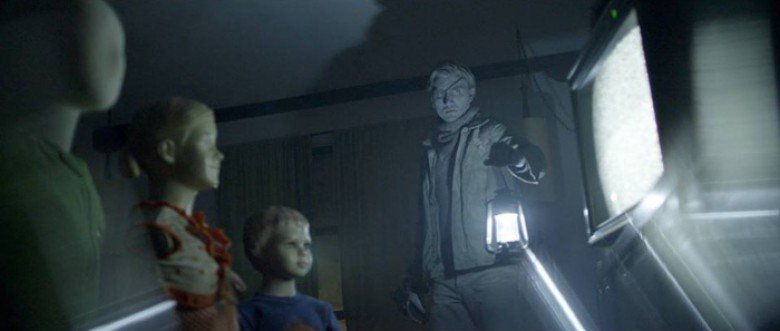“Have you seen mom and dad yet since they’ve died”
A plague has decimated Tasmania to the point where everyone is either dead or evacuated. Everyone but Sam Everett (Coy Jandreau), the youngest of three siblings yet to cope with the death of his parents, present to visit his family’s old vacation home on the island. The reason he has gone despite warnings stems from the fact that ghosts have taken over—shimmering visages from another world drawn to electricity that communicate over radio waves through recorded messages caught in the ether. Voices of those he lost and the possibility he may once more see them have made him the destination’s final inhabitant. Discovering ways to stay clear of the ghosts by hiding in cemeteries and covering his scent with the ashes of the deceased, Sam moves towards the phenomenon’s epicenter of Maria Island for answers.
One would assume we’d simply follow this loner seeking the unknown, but that’s not quite the story writer/director Jason Trost is telling. Instead he’s revealed as Brian, brother to Sam and Molly (Tallay Wickham), a man also lost in the pain of the past and the struggle of the future. Closed-off from believing himself a failure to his siblings during a childhood whose details will soon be shared, Brian is tasked with finding Sam and bringing him home. Unaware of what’s causing the quarantine and skeptical enough to dismiss a packet of information sent by his brother days earlier, he sets foot on the island with a specific purpose. Once he faces the apparitions face-to-face, however, he finally begins to understand the gravity of his situation and the notion it might be too late for them both.
A low-budget sci-fi, How to Save Us unfolds in mostly silence as we separately track Sam and Brian across Tasmania. Besides narration in the form of the former’s journals and the latter’s tape recordings, what we hear is the twangy melodies of a radio station frequently interrupted by its declaration of evacuation. This music eventually becomes synonymous with safety because as soon as the wind picks up and static pushes through to reveal voices the Everetts know all too well, we can feel the tension and fear rise to a boil. Out come the digital cameras to spy upon the anomalous silhouettes facing them and grabbing hold via infrared. Out come the ashes from canteens to form a circle around the brothers as a force field of protection. If nothing else, Trost excels at building this paranormal environment.
The absence of people and abandoned locales help in this regard as the atmosphere mimics what we see on a weekly basis from “The Walking Dead”. Sam moves through the neighborhoods writing “safe” on doors of buildings he used for the night, leaving journals with rules in the hope Brian comes searching. It’s the perfect progression of information dispersal because for all we know the mysterious things surrounding Sam are figments of his imagination—hallucinations brought on by the outbreak plaguing this island. We aren’t quite sure what’s happening or if it’s even pertinent to the missing person story at hand until Brian starts experiencing them himself. It’s ultimately proven crucial for character motivation and discovering the boogeyman’s identity, but Trost trusts us to personally engage with Brian and Sam first before letting the big picture focus.
This can be challenging initially, especially with an opening scene where Brian looks out towards an Australian skyline as Molly begs him to find Sam. Wickham’s line delivery is very broad with a hint of faux sensuality more akin to a 1-900 operator than a distraught sister. Trost’s anger is almost as unbelievable—more a frustrated temper tantrum of “Yeah! I know!” than the necessary pained response of guilt his character deserves. Thankfully things turn around, either because they legitimately got better or because I became more invested in the story to not see such budgetary constraints as transparently as before. I started to find myself within the film’s danger as soon as the ghosts increase their presence visually and aurally. It never spills fully into straight horror sensibilities, but the genre’s uneasiness definitely kept me on edge.
Trost eventually introduces psychological ramifications that simultaneously place everything occurring a bit too conveniently squared on the Everetts’ shoulders while also rendering the mystery more intense due to its personal stakes. As the brothers move forward and Molly’s past conversations with them start to expose relationship troubles, we are able to parse talk about portals and the afterlife into a physical manifestation of emotions we all feel, repress, and embrace in equal measure. Just because Brian and Sam are at the epicenter of this specific phenomenon doesn’t mean another family elsewhere isn’t experiencing the same. The universality of losing loved ones and the arduous journey to return to those who still remain makes what’s onscreen relatable and resonant. Like with “Twin Peaks”, true evil isn’t always necessarily born underneath the specific face confronting us at present.
In this respect How to Save Us proves a complex work feeding off personal feelings while projecting itself through a mainstream lens. Trost does a wonderful job bringing his concepts to life through infrared screens and light flares distorting the “other world” similar to Interstellar‘s fifth dimension with obvious smaller scale. His use of sound is also memorable as the radio transforms into a character all its own—providing a mouthpiece for evil and warning signal for conflict rolling over the horizon. And whether you read it as a grand Heaven versus Hell scenario of souls preying upon the living or a more stripped down tale about a family fractured in two (living/dead and good/bad), it works in its mission to unearth forgiveness and hope. We often make our own demons and they’re perpetually the hardest to vanquish.
Score: 6/10
Rating: NR | Runtime: 78 minutes | Release Date: November 2014 (Australia)
Studio: Parade Deck Films
Director(s): Jason Trost
Writer(s): Jason Trost

